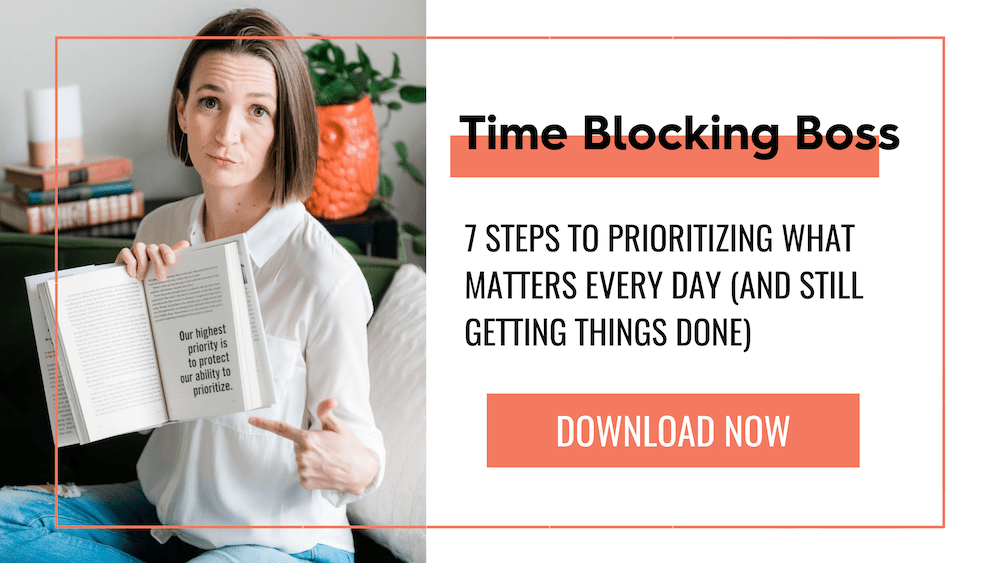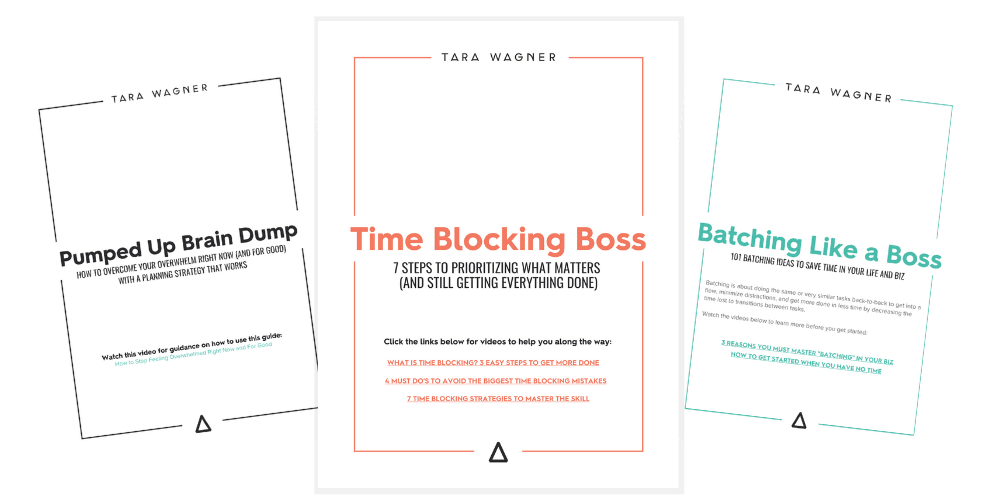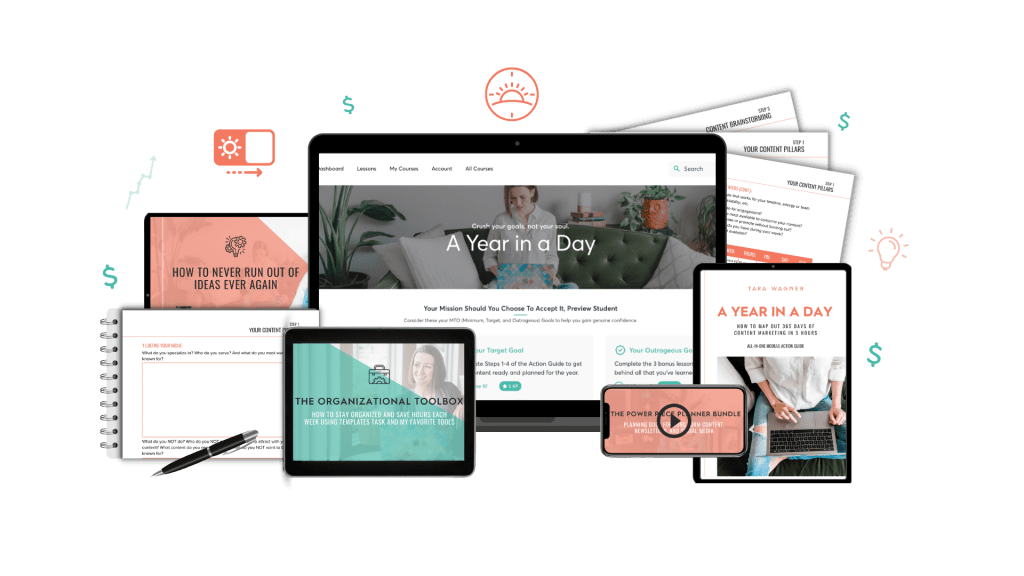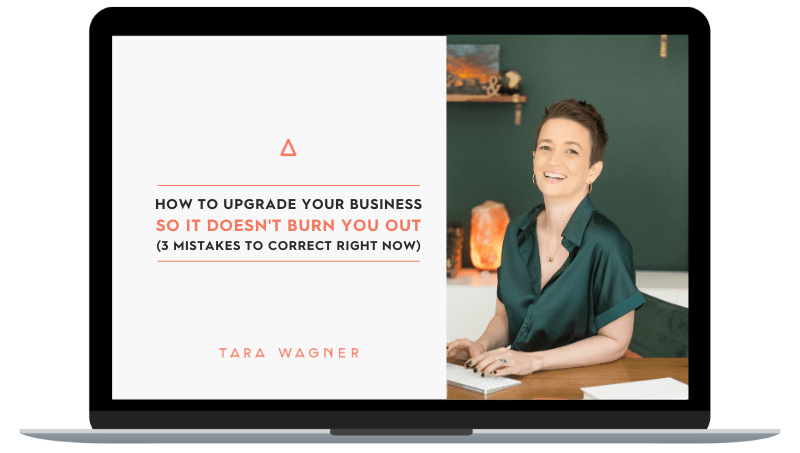At the beginning of this year I did something pretty radical. I cut my work hours in my business from out 40 or 50 hours a week down to about 20. And I didn’t cut my goals that far (maybe by like 10 or 15%).
It was a little scary. It has been testing me and challenging me in all kinds of ways, and what I want to do with this blog is walk you through, first of all, why in the world I’m doing this and then how I’m doing it. I’ll dive into what the steps were in order to be able to cut my work hours more than half, but still be able to keep on track with my goals, with my output and what I want to create this year, and not go crazy through all of that at the same time, which might be the hardest part of this entire thing…
Watch here or read below.
Okay, so first let me explain why in the world I am doing this.
Many of you already know that I live with autoimmune disorders, disabilities, and injuries that create pain, inflammation, fatigue, headaches, on and on and on. I actually counted it up one time and I have had, or currently have, over 30 different diagnoses. Some of them have been properly managed and dealt with and are no longer really a problem. Some of them are a big, glaring problem.
At the end of last year I had flare up, after flare up, after flare up. And talking to my doctor, switching doctors, talking this through with my coach, talking this through with my team, my husband, I really realized that I needed to slow way down in order to put my health as the biggest priority this year.
My whole intention with this is to be able to create more time for things like doctor’s appointments because I’m going to be working really closely with this functional medicine doctor, getting in there weekly, talking to them probably every other day.
I also just needed more time to rest. I know my body is going to need more time to recuperate, and so I wanted to be able to pad in more hours to my day where I could just do nothing. Whether that’s lay on the couch, read a book, go to bed early, sleep in late maybe, and just be able to have more time where my brain is off. Because when you’re doing work like this, and especially as a coach, you’re interacting with other people, you need a lot of creative energy.
I was just getting to the point where my body had such major demands that in order to keep things going, I had to balance it out with more rest, more downtime.
So I’m going to walk you through:
- What my new schedule looks like
- How I made this transition from 40 or 50 a week down to 20 hours a week in my business
- What were the steps I had to take to make that happen
- The little bottlenecks or the problems that I had to solve along the way
- The practical pieces of what had to give. “How do I focus my time? How do I plan out my week?”
Before I get into those steps, I just want to say, for anybody who needs to do this, I didn’t actually do this overnight. I didn’t even do it in the span of a month. Really, it was the things that I was doing a year ago, or a year and a half ago, or even three years ago, that slowly allowed me to get to this point.
So if you need this, don’t put pressure on yourself that you do it overnight. If you got to do it overnight, you’ll make it happen. But if you can’t, give yourself permission to take this one step at a time.
I started years ago by just no longer working on Sundays, and then cutting out half of my weeknights, and then cutting out Saturday afternoons. I used to work 7 days a week, 16 hours a day (in case you were wondering). So I just slowly started cutting those things out. Until last year, I was working Monday-Friday, it was about 8-5, and then on Saturday I would work maybe 9-2, 9-1 at the latest. I was doing that right up until Christmas, then I took a week off Christmas, and when I came back, I came back to 20 hours.
So I did make that final jump all at once, but again, if you can’t do that, give yourself some grace and some permission to take your time.

Take Inventory
The first thing that I did (after I talked with my doctor, after I had my coach talk me off the ledge, and I kind of/sort of talked to my husband a little bit), was I sat down and I took inventory of how I was spending my work hours.
I did this with a list of 4 things:
- My income producing activities
- My income supporting activities
- All the things that I was doing that are outsource-able
- Everything else just went into an “other crap” category
This forced me to take a long, hard look at where I was spending my time in my business, any bad habits that I had developed – where I didn’t need to be spending my time. Really what I was looking at was what needed me, my face, my brain, my focus, and what legitimately could be outsourced or let go of altogether.
Taking inventory just allows you to clarify where your time has been going, and then where you’re going to need it to go in the future in order to time block your week according to your new schedule.
Find Your focus
Once I had that list, then I could go through and I could ask myself, “What are my top 3 things? If I had to focus my time and my energy on only 3 needle-moving activities in my business, what would they be? And if I had to cut something out, what would be at the very bottom of the list in terms of priorities? What gets the ax?”
So for myself, I realized that my income producing activities are clients, videos, and launching my course. Those were the only 3 things that really matter in moving my business forward right now. Without those, nothing else means anything.
So in terms of what got the ax for me, we gave Instagram the ax. We’re no longer posting there on a super regular basis. As we decide we want to, we’re doing some stories, but it’s just not a focus. Because when I really looked at where things were happening in my business, where things were bringing in income, where it would make the most sense, Instagram just wasn’t it for me.
But this is why it’s so important to make this list and ask these questions of yourself because that’s not going to be the same for everybody.
You’re going to have to decide “what are my top 3 things and what are the things that need to get the ax for me?”
Outline Exceptions and Sacrifices
We also get to be realistic, knowing that there will be exceptions to every rule.
So what I decided to do, was sit down and look at :
- What are my exceptions?
- When are the times that I will allow myself to work outside of those hours and for how long?
When I make these decisions ahead of time, it allows me to lean on them when the opportunity comes up. Because if an opportunity comes up later and I have to make the decision in the moment, I’m going to maybe rely on feeling a little bit guilty or wanting to say yes to people when I should say no to them. Because I’ve already made that decision outside of the situation, it makes it so much easier to maintain my boundaries because I know when I can stretch those boundaries and when I really shouldn’t.
I also needed to look at what am I willing to sacrifice in order to maintain my priorities?
My #1 priority this year being health, my #2 priority being moving my business forward. So I could technically put Instagram under that category as well, but I’m also just thinking of things like what pace I wanted to go at and how I get to adjust. “What do I get to do less of?” Instead of checking Facebook every single day for 15 minutes, I’m doing it twice a week for 15 minutes now.
Most importantly for me, I had to decide how much money I’m willing to sacrifice to make this happen.
Because I want to outsource as much as I can, but I also need to be investing a lot of money in my health right now and into the protocols and the things that we’re going to be doing to move me forward in that direction.
So sitting down and looking at questions just helps you to make the decision before you’re pressured in the moment of figuring it out. That’s when we end up making rash decisions. Getting proactive and asking these questions in advance helped me to really kind of figure out some of my bottlenecks before they became bottlenecks, so that I could go into this year feeling a little bit more confident. Not perfect.
When I started this year, I did not have it all figured out. My weeks were not 100% at 20 hours. It’s taken me time and I’m still course correcting as I go along, but I would have been a hot mess had I not sat down and done some of this homework in advance.

Time Batching
Okay, so this is a really nitty gritty part. This is where I figured out my actual hours.
- How many hours am I going to be working?
- When am I going to be working?
- How am I going to be spending those hours?
And there’s 3 really important parts to this. There’s your proactive work, your reactive work, and your outside of work.
Proactive Work
I call my proactive work, my Big Rocks, and I talk about big rocks in this time blocking blog. Maybe it’s in this one. I explained the concept of big rocks, small rocks, sand and water.
For me, the big rocks are the most important things that are going to matter in the long-term. And so that is my health, but also within my business, my big rocks are those needle-moving activities, those top 3 that we talked about before. So what I’m trying to do is actually spend at least 50% of my time on those big rocks. For myself, I schedule that first in my day.
Reactive Work
Reactive work is everything like emails, text messages, Messenger, Facebook, any sort of social media, comments, anything where I’m going to be reacting with other people or connecting with other people, that comes afterwards.
I don’t look at any of that, I don’t open email, I don’t look at text messages. I don’t do anything until my big rocks have been done in the day.
So I’m actually now working Monday through Thursday. I am going from 8 AM to 11:30 on Big Rocks. I stop for a 30 minute lunch. This allows me to just ground myself, reconnect, relax a little bit, refuel, and then I go into my reactive work. Whether that’s meeting with my assistant, whether that is social media, answering emails, and that sort of thing.
My clients actually fall within both and so I actually see my clients in the morning as well as in the afternoons. That is one of my exceptions to my rule. I’m happy to see my clients later in the afternoon or early evening, simply because they give me energy and they don’t take it. But also things like Voxer and stuff like that, I won’t be working on that when I’m working on another Big Rock. If I’m working on my launch or videos, all of that is completely turned off until I’m done for the day, and then I will come back to that work and do the reactive work afterwards.
This way, my mind is more focused, I can get deeper into it. I call it my “creative cave” where I get deeper into my creative cave. I don’t feel scattered. I’m using my best energy first and then the stuff that’s a little bit easier but can be more draining, I’m doing that at the end of my afternoon. So this is usually from about 12:00 to 1:30.
Outside of Work
My after-work activities are the things that I schedule that need to be done when I need to stop working. I do this because I have a hard time stopping working. I love what I do. It’s very easy to just keep doing it, which is not great.
So what I actually do now is I schedule my doctor’s appointments at 2:00, or 2:30, or 3:00, so I know I have to be done by a certain time to be able to wind down, take a snack, get to the appointment, whatever it might be. If I’ve got a hobby, I plan to do that hobby at a certain time, so that in my mind I’m thinking, “Okay, it’s 12:30 I need to start winding down in time to be able to transition to this other thing that I want to do for myself.“
Scheduling this way forces the essential things to rise the top of the list and get done first, the non-essential things to fall to the bottom of the list.
Meaning: maybe they get done, maybe they don’t, and the things that are kind of in the middle (email, interacting with people etc.) it happens, but it doesn’t happen at the expense of your Big Rocks or your long-term vision.
Think of it like this. When I make that list, I’m going to find bad habits on it, right? Like scrolling Instagram. Now, I don’t have to try to break the bad habit of scrolling Instagram. It breaks itself because there’s just simply no time to scroll Instagram because my time is already allotted to the most important things. This is essentially following Parkinson’s law.
The size of the work will expand to the time you give it.
Parkinson’s Law
I’m not giving myself too much time, which means it forces me to focus on the important things first.
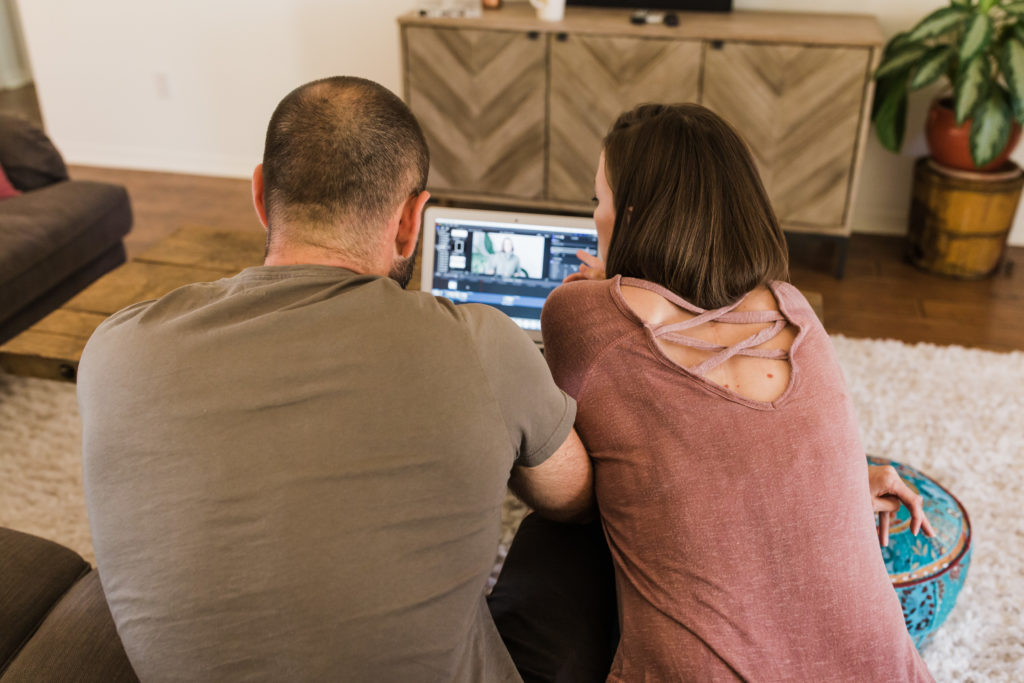
Set Expectations
After I had all of this worked out for myself, then I could go in and have some conversations and reset some expectations.
I had some conversations with my husband. We talked about what would this need to look like? What would need to shift for the both of us to be able to make this a reality? I had some conversations with my assistant, where we talked about the same thing and I just explained, “Okay, here’s how things are shifting. Here’s how I could really use you. Do you see maybe potential issues that I’m not seeing here? Do you see things that we need to address to make this work?”
Basically ask yourself the question: “What needs to happen to make this work and who needs to be on board, or who needs to be at least notified, of what’s changing?”
Here’s an example of how I did this.
I didn’t really have to make any shifts with my clients. They all kind of fell within these hours already. But one thing that I did do when it came to proofing, things like videos, proofing, copywriting, was we batched more of those tasks together.
So now when my assistant is working on creating graphics, she’s creating more of them before she’s asking me to come in and proof them. When my video editor is editing these videos, he’s editing more of them before I come in and proof them. And then my assistant is actually coming in and helping me do some proofing as well.
These were all things that are really unique to my situation that I wouldn’t have thought of had I not asked the questions that helped me to plan this out really well, and have really good conversations with people who could also help me to see some potential roadblocks, and things that we could do to really navigate this and make it work.
Manage your Mindset
The hardest part of all of this that I’ve experienced even as a belief breakthrough/mindset coach, and the hardest part that you’re going to experience, is managing your mindset.
The fear of what if I lose opportunities? The frustration as you’re working out the kinks. The overwhelm of trying to get everything done in the small amount of time that you have. Worrying what other people are going to think or say. All of that stuff that comes up is going to be the biggest piece of it because it’s going to keep you from solving the problems that need to be solved to make this work.
So just keep asking yourself, “What would have to happen in order to make this work?” This was a question that my coach asked me over and over again, “Ask better questions, Tara. What would have to happen in order to make this work?“
Don’t let your emotions, worries, fears, or doubts, stop you. Keep going at this. All of us have a messy middle.
No matter what project we’re trying to work on, no matter what our goal is, there will be a messy middle. There will be parts of this that you’re just like, “I don’t know if this can work.” Keep asking the right questions and keep chipping away at it.
When this idea of cutting my hours in half was first proposed to me, I didn’t think it was going to be possible. I had already made my list of income producing activities. I had already cut out so many things from my schedule or outsourced so many things and I was like, “It’s just not possible. I’m not going to be able to cut my hours in half and still move my business forward at anything other than a snail’s pace.“
I was wrong.
And if I hadn’t managed my mindset, thoughts, and emotions about the whole thing, I wouldn’t be where I am today, which is: able to prioritize my health, able to do some really big things for myself personally – in my health this year, and not completely losing my shit as I go through it.
It is incredible what we are capable of when we … this is going to sound like an afterschool special … when we set our minds to it. But it’s true. If you don’t give yourself an out, if you don’t give yourself another option and you just keep asking the questions:
- “How can I make this possible?”
- “What would have to happen to make this possible?”
- “What could I sacrifice?”
- “What are the things that I would shift or change?”
- “What could I do to make this thing possible?”
…your brain will begin to orient itself around possibilities.
I see things now that are possible that I could not see 6 weeks ago. Just the shift in my own mindset from this challenge, this obstacle – this thing that I wanted to do that I didn’t think I could – the shifts that happened because of that blow my mind.
So if you’re in the same situation and you need or you want to cut down your hours, or you just need or want to reach any other goal in your business, go through the steps to figure out the smartest, most practical way to do it.
Don’t let your own head be the thing that holds you back. You will not get to the good stuff if you don’t work through the messy middle.
If Time Management still seems overwhelming Grab this freebie…
I have a FREE guide called Time Blocking Boss that will help you to break your massive projects down into small, manageable tasks that actually get done and move your business forward.
You can learn more here or grab it by clicking the button below.
What about you, boss lady?
How many hours do you time block for your biz each week?
Scroll down to leave your comments below.


